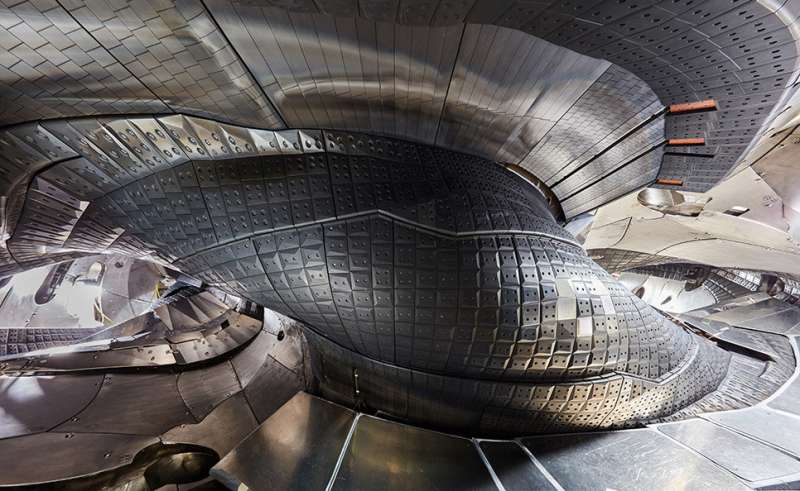Products You May Like
Physicists working on a type of fusion reactor called a stellarator are getting closer to actually harnessing the power of nuclear fusion.
According to a new paper, the Wendelstein 7-X stellarator in Germany is now capable of containing heat that reaches temperatures twice as high as those found in the core of the Sun. This means physicists have been able to reduce heat loss – a major step forward in stellarator technology.
“It’s really exciting news for fusion that this design has been successful,” said physicist Novimir Pablant of the Princeton Plasma Physics Laboratory (PPPL). “It clearly shows that this kind of optimization can be done.”
Fusion power is the focus of energy development efforts around the world. Theoretically, it relies on harnessing the energy released when nuclei in plasma fuse to produce a heavier element: the same process that occurs in the hearts of stars. If we could achieve this, the benefits would be huge – clean, high-output energy that’s practically inexhaustible.
That’s easier said than done, however. Fusion is an extremely energetic process, and containing it isn’t easy. Fusion energy was first researched in the 1940s; decades later, fusion reactors still don’t produce as much energy as they lose, by quite a significant margin – although the gap is closing.
The fusion technology currently breaking temperature records is the tokamak – a doughnut-shaped loop of plasma trapped in a shell of magnetic fields, driven at high speed in quick pulses. The relative simplicity helps contain it at high temperatures, but only in bursts.
Stellarators, on the other hand, are based on an incredibly complex configuration of magnets mapped out by an AI that can steer the plasma to keep it flowing. These are quite difficult to design and build, which has resulted in stellarators that leak quite a bit of the energy produced by fusion, in the form of heat loss.
 Wendelstein 7-X. (Bernhard Ludewig/Max Planck Institute of Plasma Physics)
Wendelstein 7-X. (Bernhard Ludewig/Max Planck Institute of Plasma Physics)
That heat loss is the result of a process called neoclassical transport, in which colliding ions in a fusion reactor cause the plasma to diffuse outwards. Its effect is greater in stellarators than in tokamaks.
Because tokamaks have their own inefficiencies, researchers at PPPL and the Max Planck Institute for Plasma Physics sought to shape the magnets in W7-X to try and reduce the effects of neoclassical transport. And now measurements, taken using an instrument called an X-ray imaging crystal spectrometer (XICS), have shown very high temperatures inside the reactor.
These are supported by charge exchange recombination spectroscopy (CXRS) measurements, which are thought to be more accurate than the XICS measurements, but could not be taken under all conditions.
But with both data sets in agreement, it seems the stellarator was able to achieve temperatures of nearly 30 million Kelvin.
This would only be possible, the team found, if there had been a sharp reduction in neoclassical transport. They conducted modelling to determine how much heat would be lost via neoclassical transport if W7-X had not been optimized, and found that 30 million Kelvin was way out of the ballpark.
“This showed that the optimized shape of W7-X reduced the neoclassical transport and was necessary for the performance seen in W7-X experiments,” Pablant said. “It was a way of showing how important the optimization was.”
This exciting result represents a significant step forward in refining stellarator design, one that will inform and shape future efforts.
It’s also a significant step towards a practical fusion reactor, although there’s a lot more work to be done. For a fusion reactor to be practical, it needs to have not just high temperatures, but the right density of plasma and decent confinement times. While tokamaks run hotter, reducing the energy lost assures stellarator technology could still hold an advantage.
“Reducing neoclassical transport isn’t the only thing you have to do,” Pablant said. “There are a whole bunch of other goals that have to be shown, including running steady and reducing the turbulent transport.”
With different nuclear fusion reactor technologies currently under development, it seems only a matter of time before one of them delivers. It may still be a while until energy generated from fusion reaches our power grids, but when it does, it might very well change the world.
W7-X is currently undergoing upgrades, and will recommence operations in 2022.
The research has been published in Nature.
